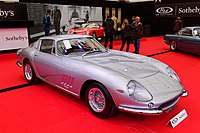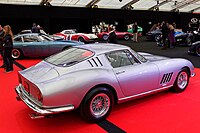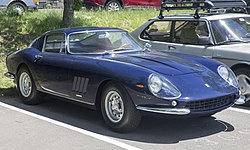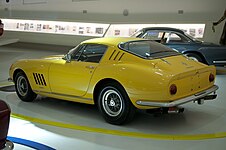Ferrari 275
| Ferrari 275 GTB, GTS, GTB/4, NART Spider | |
|---|---|
 1966 Ferrari 275 GTB Series II | |
| Overview | |
| Manufacturer | Ferrari |
| Production |
|
| Designer |
|
| Body and chassis | |
| Class | Grand tourer |
| Body style |
|
| Layout | Front-mid engine, rear wheel drive |
| Powertrain | |
| Engine |
|
| Transmission | 5-speed manualtransaxlewith synchromesh |
| Dimensions | |
| Wheelbase | 2,400 mm (94.5 in) |
| Curb weight |
|
| Chronology | |
| Predecessor | Ferrari 250 |
| Successor | |
TheFerrari 275is a series offront-enginedV12-poweredgrand touring automobileswith two-seatercoupéandspiderbodies produced byFerraribetween 1964 and 1968. The first 275 series cars were powered by a 3.3 L (3286 cc)overhead camshaftColombo60°V12 engineproducing 260–320 hp (190–240 kW). An updated 275 GTB/4 was introduced in 1966, with a revised four overhead camshaft engine producing 300 hp (220 kW). The 275 series were the first road-going Ferraris equipped with atransaxleandindependent rear suspension.[2][3]
Pininfarinadesigned the 275 coupé and spider bodies,[2]whileScagliettidesigned the 275 GTS/4 NART Spyder, of which only 10 were made.[4]
Motor Trend Classicnamed the 275 GTB coupé/GTS spider as number three in their list of the ten "Greatest Ferraris of all time",[5]and the 275 GTB/4 was named number seven onSports Car International's2004 list ofTop Sports Cars of the 1960s.In a September 1967 road test,Road & Trackdescribed the NART Spyder as "the most satisfying sports car in the world."[6][7]
Two-cam models
[edit]All 275 coupé and spider models built from 1964 until the 275 GTB/4's introduction in 1966 were equipped with an overhead cam 3.3 litre V-12 engine (one camshaft for each cylinder bank). These early models are often called "two-cam" cars to distinguish them from later 275 models.
275 GTB
[edit]The275 GTBwas a two-seatgrand touringcoupéproduced between 1964 and 1966. The name of this model was derived from the engine's per-cylinderdisplacementof 275 cc and the Italian designationGran TurismoBerlinetta.
The 275 GTB used a double overhead cam 3.3 litreColombo-designed 60º V-12 engine[8][9]designatedTipo 213.[10]This engine was the final development of the Colombo V12, with astrokeof 58.8 mm and aboreof 77 mm. The internal parts of the engine were derived from those used in other Ferrari models including the250 GTE 2+2,250 Lussoand250 GTO.Three twin-chokeWeber40 DCZ 6 or 40 DFI 1carburetorswere equipped as standard.[10]Power was claimed to be 280 horsepower (210 kW) at 7600 rpm, but provided closer to 240-250 hp (190 kW) in actual use.[11]A factory option of six twin-choke Weber 40 DCN carburetors was also available, which Ferrari claimed provided 320 hp (240 kW) at 7500 rpm[3]although the actual increase in power over the three-Weber setup was likely only 20-25 hp.[11]The rear wheels were driven by a5-speed manualtransaxlewithPorsche-stylesynchromeshand alimited-slip differential.This was the first time a transaxle was used on a Ferrari production road car, although they were used on some earlier Ferrari competition models such as the250 Testa Rossa.[3][11]
The 275 chassis was a conventionalladder framedesign fabricated from oval-section steel tube.Mike Parkeshad a major role in developing the 275's suspension, which employed many technologies tested in earlier Ferrari racing cars such as the250 TRand250 LM.Double wishboneindependent suspensionwas used at all four wheels along withKonishock absorbersandcoil springs.The 275's four-wheel independent suspension was a first for Ferrari road cars, which were previously equipped withlive rear axles.Dunlopdisc brakeswere equipped at all four wheels, although even during the mid 1960s they were considered inadequate due to small size, lack of ventilated discs, and an underpowered servo and caliper.Cast magnesium14 inch diameter wheels were standard equipment, withBorraniwire wheelsavailable as a factory option, both wheel options came fitted with Pirelli 205VR14 Cinturato CN72 tyres.[3][12]
The 275 engine was initially mounted to the chassis at four points, each insulated by a thin rubber pad in road cars or an aluminium spacer in competition versions. The transaxle was similarly mounted to the rear of the chassis at three points. Engine and transaxle were connected via a rigid drive shaft, supported by a central bearing. This mounting arrangement allowed the engine and transaxle to act asstressed membersof the chassis. This improved overall rigidity, but caused increased noise and vibration and required careful alignment. At the end of 1965, the driveshaft was revised with the addition ofCV jointsat either end, which allowed some flexibility and misalignment between the engine and transmission. This system was retrofitted to some earlier production cars and was also installed in some early 1966 production series two "long nose" cars prior to the introduction of the torque tube.[13]
The coupé body was designed byPininfarinaand manufactured byScaglietti.The standard 275 GTB body was fabricated in steel with aluminium alloy doors, hood and trunk lid. At least 72 cars[11]were built with a lightweight all-aluminium body, which was an extra-cost option from the factory.[3]
A series two, or "long-nose" version of the 275 GTB was introduced in 1966. The second series 275 GTB incorporated a number of mechanical and cosmetic changes. Atorque tubewas installed between the engine and transaxle in order to relieve stress on thedrive shaftand central support bearing. The engine and transaxle were revised to use two chassis attachment points each, rather than the four engine mounts and three transaxle mounts used on earlier cars. As a result, the engine and transaxle were now a rigid unit, flexibly suspended within the chassis by a total of four points. As the engine/transaxle were no longer stressed members, the chassis was slightly softer and noise/vibration issues seen on series I cars were improved.[13]The front bodywork was lowered and lengthened and the front air intake was reduced in size, which improved aerodynamic characteristics and reduced high-speed instability. This was the most visible change between the two series, resulting in the common informal designation of series I cars as "short nose" and series II as "long nose." The rear window was enlarged to improve visibility. In order to improve luggage space, the fuel filler, fuel tanks and spare tyre were relocated and the trunk hinges were changed from internal to externally-mounted.[2][3][11]
A total of 442 of the 275 GTB road cars were produced between fall 1964 and summer 1966, including 236 Series I "short-nose" and 206 Series II "long-nose" cars.[11]
-
1965 Ferrari 275 GTB, Series I "short nose"
-
275 GTB, Series II "long nose" with optional aluminium alloy bodywork
-
Note the B-pillar and roof panel gap denoting alloy bodywork
-
Rear view of 275 GTB Series II (Note the B-pillar and roof smooth connection of steel bodywork)
Competition versions
[edit]From 1964 to 1966, Ferrari developed competition versions of the 275 GTB for use inGrand Touring-class sports car racing.Initial development of a 275 GTB-based racing car was motivated by a specific set of circumstances around Ferrari's racing activities during 1964. The 1962–1963250 GTOwas extremely successful in GT-class racing but was nearing obsolescence in 1964. The 250 GTO's planned successor, the 250 LM, was introduced to the public in November 1963, but theFédération Internationale de l'Automobile(FIA) refused tohomologateit for GT-class racing. In response, Ferrari decided to prepare for the 1964 season by developing in parallel both an updated 250 GTO (called the series II or GTO64) and a competition version of the 275 GTB. Between 1964 and 1966, Ferrari created three distinct series of 275 GTB-based competition cars, the purpose-built 1964/65 275 GTB Competizione Speciale (also known as the 275 GTB/C Speciale), a 1965 group of modified production 275 GTB "customer competition" cars for independent racing teams, and the final development, the purpose-built 1966 275 GTB/C.[14]
275 GTB Competizione Speciale
[edit]The first racing version of the 275 was the275 GTB Competizione Speciale(or275 GTB/C Speciale). Designed under the supervision ofMauro Forghieri,[15]this model was intended to succeed the 250 GTO as Ferrari's GT-class entry during the 1965 racing season. Ferrari constructed four cars of this type, three of which were manufactured between late 1964 and early 1965, while the fourth was completed in 1966.[16]These cars were equipped withTipo 213engines tuned to250 LMspecification, producing approximately 290-305 bhp (227 kW). The extra-thin-gauge alloy bodywork (designed byPininfarinaand built byScaglietti) was significantly different from the production 275 GTB, with a more streamlined shape similar to the 250 GTO and the330 LMB.[14]All four cars had slightly differing hand-built bodywork, possibly due to ongoing aerodynamic experimentation by Ferrari engineers.[17]The chassis was a lightweight version of the productionTipo 563chassis using smaller diameter tubing. Additional weight reduction was accomplished by drilling holes in interior panels,Plexiglaswindows, and the use ofmagnesiumcastings for parts of the engine and transaxle.[14][18]The owner of one 275 GTB/C Speciale (chassis 6885) estimated the curb weight as approximately 1,900 pounds (860 kg).[15]
TheFédération Internationale de l'Automobile(FIA) at first refused tohomologatethe model for the GT class but settled on a compromise whenEnzo Ferrarithreatened to abandon competing in the GT class.[19]Due to this delay, only one 275 GTB/C Speciale (chassis 6885) raced during the 1965 season. This car competed at the1965 Targa Florio,where was driven by Bruno Deserti and Giampiero Biscaldi but failed to finish. The car placed 13th overall at the 19651000km Nürburgring,driven by Biscaldi andGiancarlo Baghetti.It finished 3rd overall at the1965 24 Hours of Le Mans,where it was driven byWilly Mairesseand Jean Blaton (under the name "Beurlys" ) forEcurie Francorchamps.Following Le Mans, the car placed 11th overall at the 1965 500 km ofBridgehamptonand won the 1965 Nassau Tourist Trophy.[14][15][18][20][21]
Due to its role as a 250 GTO successor and its visual similarities with that model, the 275 GTB/C Speciale is sometimes referred to as the "GTO '65", although this was never an official factory designation.[14][15][18]
A 1964 275 GTB/C Speciale (chassis 06701) was sold in 2014 by RM Sotheby's at their California auction for $26,400,000.[22]
275 GTB customer competition cars
[edit]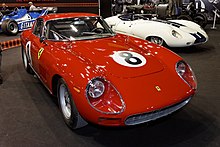
Following the creation of the 275 GTB/C Speciale and the subsequent homologation struggles, Ferrari decided to create a less-radical competition 275 GTB to be sold to private racing teams. Ten cars of this type were produced. These customer competition (or in Italian "competizione clienti") cars were very similar to the production 275 GTB, differing only in the alloy bodywork, extra venting, added exterior fuel fillers and expanded capacity fuel tanks. The engine was aTipo 213unit with 6 carburetors, the same as fitted to production road-going 275 GTBs. These customer-competition 275 GTBs were created both to test the market for this type of GT racing car and as a gesture of compliance to the FIA, in hope of positively influencing the homologation process.[14][23][24]
275 GTB/C
[edit]
For the 1966 season, Ferrari built a new series of 12 lightweight275 GTB/Cracing cars. Even though they outwardly resembled the road-going 275 GTB, the 275 GTB/C was thoroughly revised byMauro Forghieriand his Scuderia Ferrari engineering team and differed from both the 275 GTB production car and earlier 275 GTB competition cars. Every panel of the body was altered and substantial mechanical changes were made. All 12 were constructed in 1966 between the end of the 275 GTB (two cam) production run and the start of the 275 GTB/4 (four cam) production run.[14]
Forghieri designed a special super-lightweight steel and aluminium version of the 275 GTB chassis, designatedTipo 590 A.The 4-wheel independent suspension was the same design as on the production 275 GTB, but used differentshock absorbervalving and stiffer springs. The disc brakes were also the same as those used on the production 275 GTB, but with quick-change racing brake pads.[14]
The body appeared superficially very similar to that of the production 275 GTB series II "long nose", but in fact was a completely new lightweight version constructed by Scaglietti. All body panels were changed, including wider front and rear fenders and a slightly shorter nose. The body was constructed from.028 in (0.71 mm) thick aluminium panels joined withrivets.This method of construction allowed easy replacement of body panels after an accident. The body panels were approximately half as thick as the ones used on the 250 GTO and theShelby Cobra.This made the body lightweight but extremely fragile—even leaning on a 275 GTB/C would dent it. The entire rear section was reinforced byfiberglassto prevent it from fle xing at the slightest impact. The 275 GTB/C was equipped with bumpers visually similar to those on the road version, but they were made of much thinner material. The rear bumper lacked an internal supporting subframe and was simply fastened to the bodywork sheetmetal. Other weight-saving measures included removal of cooling fans, holes drilled in many internal panels and frames, plexiglass side and rear windows, thin fiberglass floor panels, and magnesium-framed seats. A 275 GTB/C fully equipped with fluids, spare tyre and tool kit weighs 2,452 lb (1,112 kg). In race trim without spare and tool kit, it can weigh less than 2,350 lb (1,070 kg), a savings of over 150 kg (331 lb) compared to the alloy bodied road cars.[14][23]
Similar to the four 'Competizione Speciales', the 275 GTB/C was powered by aTipo213V12 tuned to250 LMspecification with a special crankshaft, piston, camshaft connecting rods and sodium-filledNimonicvalves.Many engine castings were made from the lightweight magnesium alloyElektron.Due to an apparent clerical error, Ferrari did not report to the FIA that the production 275 GTB had a six carburetor option, so only a three carburetor engine could be homologated. In order to make up the loss of power from using only three carburetors,Weberconstructed the 40 DF13 carburetor. These replaced the six Weber 38 DCN carburetors used on the 250 LM and were unique to the 275 GTB/C. A dry sump lubrication system was also added, allowing the engine to sit lower in the chassis. TheTipo213 engine in this competition specification produced 275-282 hp (210 kW) at 7500 rpm.[14][23]
The 275 GTB/C did not use the torque tube driveshaft configuration introduced with the 275 GTB series II, instead using a series I-style open driveshaft which made clutch changes easier during endurance races.The clutch itself was strengthened for the added stresses of racing. The transaxle was a similar design to the road version, but used a lightweight magnesium case,close ratio gears,a strengthenedZFlimited slip differential andneedle bearings(instead ofplain bearings) between the gears and the main shaft.[14]
The 275 GTB/C was fitted with specially-madeBorraniwire wheels, sized 7 "x 15" in front and 7.5 "x 15" in the rear. These wheels were fitted withDunlop'slatest "M series" racing tyres. It was this combination that would prove to be the weak spot of the 275 GTB/C; the tyres had so much grip that they could overstress and break the spokes on the wheels. This resulted in several crashes during competition. After the 275 GTB/C, no competition Ferrari would be fitted with wire wheels again. Two of the twelve 275 GTB/Cs built were sold for street use. Unlike the race cars, these street cars were fitted with standard 275 GTB-style alloy wheels withPirellityres.[14]
After its introduction in 1966, the 275 GTB/C was raced by several independent racing teams with varying degrees of Ferrari factory support, includingNART,Maranello Concessionaires,Scuderia Filipinetti,andEcurie Francorchamps.Three 275 GTB/Cs were entered in the1966 24 Hours of Le Mans,two of which finished. The Maranello Concessionaires-entered 275 GTB/C (chassis 09035) driven by Roy Pike andPiers Couragefinished 8th overall and 1st in class, while the Ecurie Francorchamps 275 GTB/C (chassis 09027) driven by Claude Dubois and Pierre Noblet finished 10th overall and 2nd in class.[14][23][25][26]Other notable victories include a 1st in class at the 1967 Targa Florio, driven by Tullio Sergio Marchesi. Marchesi went on to win the 1966 and 1967 Italian GT Championships driving 275 GTB/C chassis 09007.[14][27]
275 GTS
[edit]
The275 GTSwas a two-seat grand touringspiderproduced from 1964 to 1966. The 275 GTS was introduced at the same time as the 275 GTB and was mechanically almost identical, sharing the 3.3 litre V12, transaxle, chassis and fully independent suspension. Ferrari reported that the engine fitted to the 275 GTS produced 260 bhp (190 kW). This was less than the reported 280 bhp produced by the 275 GTB, although there was likely no difference in engines between the models. The 275 GTS was never equipped with a torque tube, unlike the 275 GTB series II.[28][29]This model was fitted with 205Vr15 Pirelli Cinturato CN72 tyres on Borrani wire wheels.[citation needed]
The all steel 275 GTS body was designed and manufactured by Pininfarina. Its appearance was entirely different than that of the 275 GTB coupé, with a shorter front hood, smaller uncovered headlights, and overall balanced proportions suggesting earlier250 Pininfarina Cabrioletmodels. All 275 GTS were equipped with a folding clothconvertible topand an additional removable hard top was a factory option.[28][29]
Ferrari produced a total of 200 275 GTS between late 1964 and early 1966, including 19 in right hand drive.[28]The 275 GTS was replaced in 1966 by the330 GTS,leaving no 3.3 L spider in the range until the creation of the275 GTB/4 NART Spider.
Four-cam models
[edit]The 275 GTB/4 and GTS/4 NART spyder models made up the final production run of the 275 series, between 1966 and 1968. They were equipped with a four overhead cam 3.3 litre V-12 engine, a development of the double overhead cam 275 engine used from 1964–1966. The later 275 models are often called "four-cam" cars to distinguish them from earlier 275 models.
275 GTB/4
[edit]Introduced at theParis Motor Showin October 1966,[8]the275 GTB/4(or 4-cam) used the same basic platform as the early 275 GTB with mostly mechanical improvements. TheScaglietti-built bodywork was largely the same as the series II "long-nose" 275 GTB, with the most visible difference being an added hood bulge with creased edges.Campagnolomagnesium alloy wheelssized 14x7 were standard equipment, while traditional Borrani wire wheels were a special-order option.[30]
The engine was theTipo 2263285.72 ccColomboV12,derived from the earlierTipo 213275 engine with two valves per cylinder, but now upgraded with four overhead camshafts and six Weber 40 DCN carburetors as standard. This engine produced a claimed 300 hp (220 kW).[10][30]In a departure from previous Ferrari designs, the valve angle was reduced three degrees to 54° for a more-compact head.[citation needed]The dual camshafts also allowed the valves to be aligned perpendicular to the camshaft instead of offset as inSOHCengines. The engine used adry-sumplubrication system with a large 17 qt (16 L) capacity.[30]
Improvements from the series II 275 GTB were carried over to the 275 GTB/4, including the torque tube connecting the engine and transmission. In addition to the upgraded engine, the 275 GTB/4 had several minor improvements to the cooling system, exhaust and suspension.[30]
The 275 GTB/4 had a claimed top speed of 268 km/h (167 mph).[9]A total of 330 were produced from 1966 to 1968.[9][30]
In 2004,Sports Car Internationalnamed the 275 GTB/4 number seven on the list ofTop Sports Cars of the 1960s.
-
1967 275 GTB/4
-
275 GTB/4 at theMuseo Casa Enzo Ferrari
-
1967 275 GTB/4 interior
275 GTB/4S NART Spider
[edit]The275 GTB/4S NART Spiderwas a roadgoing two-seater spider version of the 275 GTB/4, 10 of which were built in 1967. Production of this car was initiated by Ferrari's North American dealer,Luigi Chinetti,who wanted a successor to the earlier250 California Spiderseries.[4]He askedSergio ScagliettiandEnzo Ferrarito build a spider version of the 275 GTB/4, which Chinetti bought for approximately $8,000 each,[citation needed]and listed at $14,400 retail.[7]These cars were informally named NART Spiders, referring to Chinetti'sNorth American Racing Team.While the name "NART" was never part of this model's official designation from the factory, acloisonnébadge with the team's logo was installed on the rear of each car.[4]
Chinetti intended to order 25 NART Spiders from Scaglietti, but because of low sales[3]just 10 were built in 1967 and 1968, making this one of the rarest 275 models.[4][31]The ten NART Spiders used chassis numbers 09437, 09751, 10139, 10219, 10249, 10453, 10691, 10709, 10749, and 11057.[32]
The magazineRoad & Trackpublished a road test of a then-new NART Spider in its September 1967 issue, describing it as "the most satisfying sports car in the world." This test recorded a 0-60 mph (97 km/h) time of 6.7 seconds, a1⁄4mile (0.40 km)drag striptime of 14.7 seconds. and a top speed of 155 mph (249 km/h).[7]
The first produced 275 GTB/4S (chassis 09437) was entered in the 196712 Hours of Sebring,driven byDenise McCluggageand Marianne Rollo. They finished 17th overall, and 2nd in the 5-litre GT class. Following this race, the car was repainted from its original "Giallo solare"yellow to a burgundy colour for an appearance in the 1968 filmThe Thomas Crown Affair,where it was driven byFaye Dunaway's character.[4][6]The same car was subsequently tested by Road & Track for their September 1967 road test article. In August 2005, 09437 sold for $3.96 million atGooding & Co.'sPebble Beachauction.[33]
In August 2013, a 1967 275 GTB/4S NART spider (chassis 10709) sold forUS$25 million(US$27.5m after commissions) atRM Sotheby'sMonterey,California auction. At the time of the auction, this was a one-owner car, previously owned by Eddie Smith of Le xing ton, North Carolina. Mr. Smith purchased it new in 1968 and drove it regularly until his death in 2007. Subsequently, the car remained in possession of his family until the 2013 auction sale.[34][35]Mr. Smith Jr. felt that the car was "sort of being imprisoned" hence the reason for the selling it. The winning bid was byLawrence Stroll,collector and part-owner ofAston Martin Formula One team.The Smith family announced that the proceeds of the sale will be donated to charity.[36]
References
[edit]- ^Furman, Michael (25 August 2006)."1964-1968 Ferrari 275GTB, GTB/4".Motor Trend.Retrieved16 April2023.
- ^abcMerritt, Richard F.; Fitzgerald, Warren W.; Thompson, Jonathan (1976).Ferrari: the Sports and Gran Turismo Cars(3rd ed.). CBS Publications. pp. 170–177.ISBN0878800190.OCLC946498945.
- ^abcdefgWebb, Ian (1981).Ferrari 275GTB & GTS: 2-cam, 4-cam; 'Competizione'; Spider.London: Osprey.ISBN0850454026.OCLC16549966.
- ^abcdeWetmore, Dustin (October 2018). "The NART Spyder".Cavallino.227:36–46.
- ^Goodfellow, Winston (21 November 2005)."A Perfect 10: The Greatest Ferraris Of All Time".Motor Trend.Retrieved13 May2015.
- ^abGoodfellow, Winston (2 December 2006)."Drive: 1967 Ferrari 275 GTB/4 NART Spyder – Scene Stealer".Motor Trend.Retrieved13 May2015.
- ^abc"Ferrari 275 GTS/4 NART".Road & Track.19(1): 54–57. September 1967.
- ^ab"Design Analysed: Ferrari 275 GTB4".Autocar.126. Vol. (nbr 3703). 2 February 1967. pp. 4–8.
- ^abc"Ferrari 275 GTB4".Ferrari GT - en-EN.Retrieved11 January2016.
- ^abcReggiani, Francesco; Bluemel, Keith (2018).Ferrari Engines Enthusiast's Manual.Sparkford, Yeovil, Somerset U.K.: Haynes. pp. 76–89.ISBN978-1-78521-208-6.OCLC1023488164.
- ^abcdefRidgely, Dyke W. (January 1980). "275 GTB".Cavallino.9:24–29.
- ^"Ferrari 275 GTB (1964) - Ferrari".Ferrari GT - en-EN.Retrieved17 October2018.
- ^abPourret, Jess G. (1984).Ferrari 275 GTB, 275 GTS, 275 GTB-4A(in French). Levallois-Perret, France: Publi-Inter.ISBN2-903356-10-6.OCLC19724359.
- ^abcdefghijklmnRidgley, Dyke (December 1988). "The 275 GTB/C - A History".Cavallino.48:26–33.
- ^abcdRosetti, Giancarlo (May 2005). "Legend of the GTO 65".Forza.61:36–42.
- ^Bluemel, Keith (April 1999). "275 GTB/C Speciale 06701 GT".Cavallino.110:22–28.
- ^Simmons, Clem (September 1999). "Lettere".Cavallino.112:6–7.
- ^abc"1965 Ferrari 275 GTB/C - Speciale - RM Sotheby's".classicdriver.Classic Driver. Archived fromthe originalon 12 November 2018.Retrieved11 November2018.
- ^Owen, Richard Michael."Ferrari 275 GTB/C Speciale".Supercars.net.Retrieved12 January2016.
- ^"275 GTB/C 06885".barchetta.cc.Retrieved10 November2018.
- ^"1965 Le Mans 24 Hours | Motor Sport Magazine Database".Motor Sport Magazine.13 June 2017.Retrieved11 November2018.
- ^"1964 Ferrari 275 GTB/C Speciale by Scaglietti | Monterey 2014".RM Sotheby's.Retrieved11 August2021.
- ^abcd"1966 Ferrari 275 GTB/C - Berlinetta Competizione - RM Sotheby's".classicdriver.Archived fromthe originalon 12 November 2018.Retrieved11 November2018.
- ^"1965 Ferrari 275 GTB - Competizione Clienti - Rick Cole Auctions".classicdriver.Retrieved11 November2018.
- ^"275 GTB/C 09035".barchetta.cc.Retrieved11 November2018.
- ^"275 GTB/C 09027".barchetta.cc.Retrieved11 November2018.
- ^"275 GTB/C 09007".barchetta.cc.Retrieved11 November2018.
- ^abcRidgley, Dyke. "275 GTS".Cavallino.13:28–34.
- ^ab"Ferrari 275 GTS (1964) - Ferrari".Ferrari GT - en-EN.Retrieved18 October2018.
- ^abcdeRidgley, Dyke W. (August 1986). "The Four-Cam".Cavallino.35:16–26.
- ^"Ferrari 275 GTB/4".HowStuffWorks.Archived fromthe originalon 23 September 2017.Retrieved26 May2014.
- ^"Barchetta Register".September 2017.[permanent dead link]
- ^"275 GTB/4 NART Spider 9437".barchetta.cc.Retrieved14 October2018.
- ^"One careful owner, this Ferrari is yours for just £17.6m".Metro.UK. 18 August 2013.Retrieved22 March2017.
- ^"1967 Ferrari 275 GTB/4*S N.A.R.T. Spider by Scaglietti | Monterey 2013".RM Auctions.August 2013.Retrieved14 October2018.
- ^Lamm, John (27 August 2013)."Eddie's Money: The Story Behind the $27.5-Million Ferrari NART Spider".Car and Driver.US.Retrieved18 August2021.
External links
[edit] Media related toFerrari 275at Wikimedia Commons
Media related toFerrari 275at Wikimedia Commons


